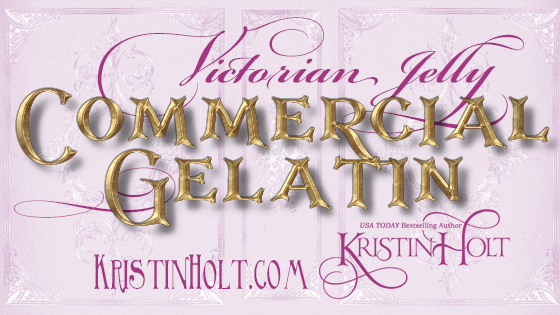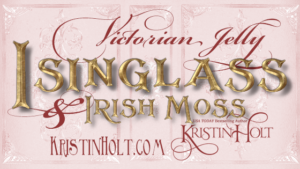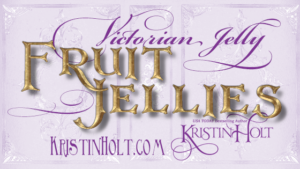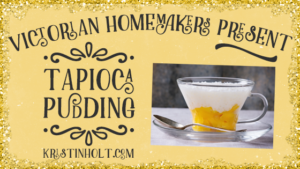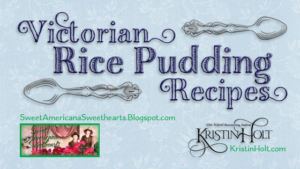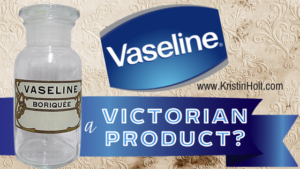Victorian Jelly: Commercial Gelatin
Victorian Jelly: Commercial Gelatin
.
Inventive Victorians: Gelatin in a Paper Box
.
Credit goes to a Victorian-era inventor for out-of-a-box gelatin. What an amazing labor-saving invention! Until now, wives and daughters everywhere had been making gelatin out of pigs feet and a good deal of elbow grease.
.
How did nineteenth century scientists manage to capture the essence of gelatin and put it in a box?
.
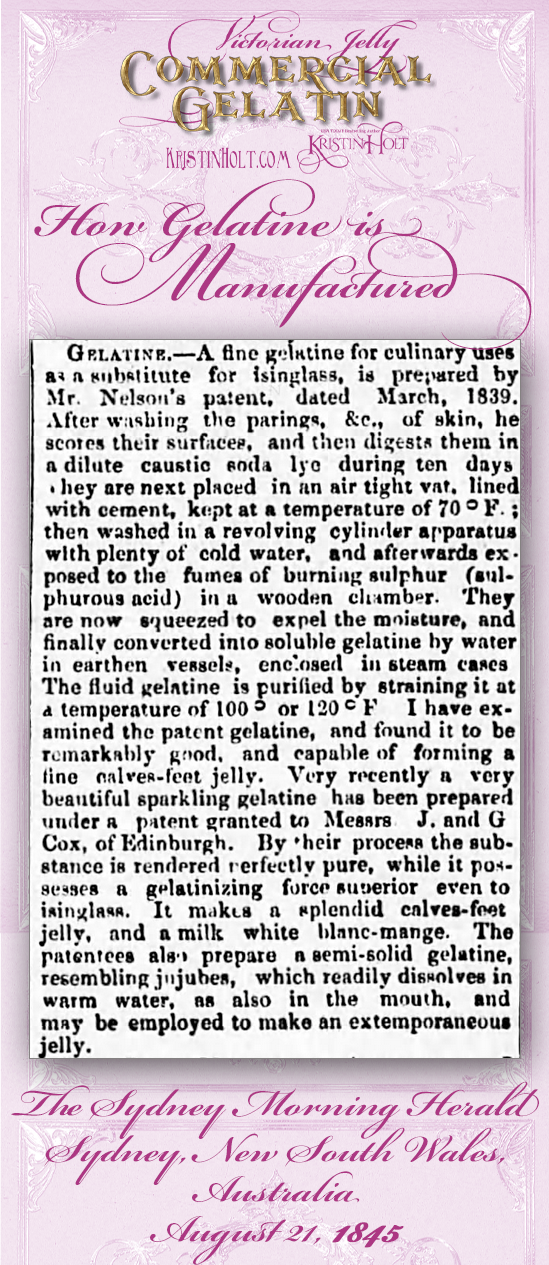
How Gelatin is Manufactured. From The Sydney Morning Herald of Sydney, New South Wales, Australia. Dated August 21, 1845. Applications include “a milk white blanc-mange” and “calves-feet jelly.” Ad proclaims, “superior even to isinglass.” Article mentions Messrs J. and G. Cox of Edinburgh who obtained a patent for their process that renders perfectly pure gelatine.
.
New Brands in Gelatine
.
Nelson’s Patent Opaque Gelatine
.
Nelson’s Gelatine [sic] arrived on the British scene in about 1840. “Half the price of Isinglass!” this advertisement claims. Nelson’s Patent Opaque Gelatine was sold in packets at chemists and grocers in the United Kingdom.
.

Advertisements for Nelson’s Gelatine. From Bristol Mercury and Daily Post, Western Countries and South Wales Advertiser of Bristol, England on November 5, 1841. Also from The Buffalo Commercial of Buffalo, New York, June 5, 1844.
.
Woolaston’s Gelatine
.

Advertisement for Woolaston’s Gelatine in The Morning Post of London, England, March 19, 1845.
.
Cox’s Gelatine
.

Cox’s Gelatine advertises in Liverpool, England (1844); Bangor, Maine (1848); and Vicksburg, Mississippi (1850).
.
Paulsen’s Gelatine
.

Paulsen’s Gelatine advertises in The Buffalo Courier of Buffalo, New York. July 23, 1852.
.
Knox’s Gelatine
.
The Food and Health Exposition succeeded in New York City (March 1891). Sponsored by grocers, the huge event introduced consumers to commercial grocery products in a highly advertised and well-attended fair lasting eighteen days. A smattering of 1891 American newspapers created a picture of this exposition, outlining the grocers’ intentions, featured articles (“products” to you and me), a warm reception from the public for the “free lunch”, and more.
Buoyed by New York’s success, Boston’s merchants and manufacturers soon planned a Food and Health Expo for Boston (October 1891). Knox’s Gelatine was on display at the Food and Health Exposition in Boston.
.
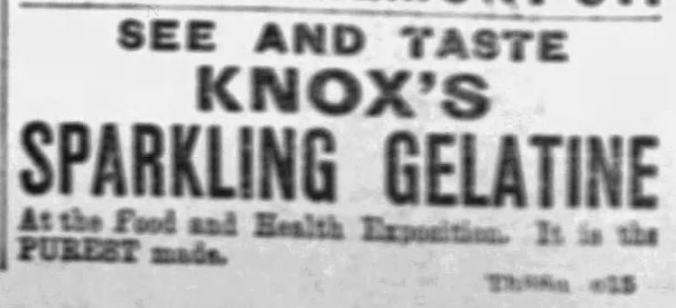
Advertisement in The Boston Globe on October 15, 1891. “See and Taste Knox’s Sparkling Gelatine At the Food and Health Exposition. It is the PUREST made.”
.

Food and Health Exposition features Knox’s Gelatine. From The Brooklyn Times of Brooklyn, New York, February 9, 1892. Fleishmann & Co. Yeast exhibited nearby Knox’s booth.
.

Knox’s Gelatine advertises in the Boston Cooking-School Cook Book, 1st edition. By Fannie Merritt Farmer, 1896.
.
And Many More Brands, and some Unbranded
.
My handful of Victorian commercial gelatin brands is far from exhaustive. Numerous others existed in the United States throughout the Victorian era.
Newspaper advertisements often simply stated “gelatine packets,” attributed to no brand at all. Perhaps local consumers knew what brands of gelatin could be found at so-and-so’s market, hence no need to expend space in an advertisement.
.

Unbranded gelatine for blanc mange for sale at pharmacy. Published in Detroit Free Press of Detroit, Michigan on June 19, 1848.
.
Recipes with Commercial Gelatin
.
Victorian cooking methods often appear exhausting to contemporary culinary enthusiasts. Simply maintaining the fire in the stove required attention and effort few today understand (I certainly don’t). Recipes for the many and various Victorian Jelly Desserts sketch a scene involving hours laboring over a stove, jelly bag, basins, and ice to create the confection. The advent of affordable commercially prepared gelatin changed the game forever.
Nineteenth century recipe books began to call for dry gelatine. “Dry” is assumed in instructions such as “soak for 30 minutes” and “dissolve in boiling coffee.” What a breakthrough in time-saving magic this must’ve seemed to Victorian cooks.
.

Recipes call for commercial gelatine. Recipes for Lemon Jelly, Coffee Jelly (Our Home Favorites, 1882) and Lemon Jelly (The Homemade Cook Book, 1885).
.

Wine Jelly, Coffee Jelly, and Celestial Hash. Published in Receipt Book of the Improvement Society of the Reformed Church, New Brunswick, New Jersey, 1890.
.

Buttercup Jelly from The Columbian Cook Book, 1892. This Jelly is enriched with milk (full fat, naturally) and eggs. The pinch of soda certainly served a purpose. Do you know why?
.
Did you notice where the Buttercup Jelly recipe came from? The Columbian Cook Book featured foods and commercially prepared foods shown off at the World’s Columbian Exhibition (The Chicago Fair). Along with well-known Victorian debuts such as Shredded Wheat and Aunt Jemima’s Pancake Mix.
.

Orange Jelly in Baskets from Three Hundred Tested Recipes, 1895.
.
![Kristin Holt | Victorian Jelly: Commercial Gelatin. Recipes for Lemon Cream (molded gelatin dessert), or substitute Cocoanut [sic] or Pineapple. From Three Hundred Tested Recipes, 2nd Edition, 1895. Kristin Holt | Victorian Jelly: Commercial Gelatin. Recipes for Lemon Cream (molded gelatin dessert), or substitute Cocoanut [sic] or Pineapple. From Three Hundred Tested Recipes, 2nd Edition, 1895.](https://www.kristinholt.com/wp-content/uploads/2022/05/Jelly-Commercial-gelatin-Lemon-Cream-300-Tested-Recipes-1895.png)
Recipes for Lemon Cream (molded gelatin dessert), or substitute Cocoanut [sic] or Pineapple. From Three Hundred Tested Recipes, 2nd Edition, 1895.
.

Coffee Jelly recipe, along with wisdom: “in summer, gelatine desserts must be put on ice, or they will not harden.” From Three Hundred Tested Recipes, 2nd Edition, 1895.
.

Russian Jelly recipe from The Boston Cooking School Cook Book, 1896.
.
Today’s cooks may notice none of these vintage recipes call for added color, until this next Wine Jelly. Why not? Victorian-era cooks relied on wine and fruit to color their gelatin confections (and savory side dishes). Packets or boxes of Victorian gelatin was unflavored, like today’s Knox’s Gelatin.
This following example is rare in that it calls for “Fruit red,” an added food colorant. We’ve seen other examples of food coloring in Victorian Jelly: Blanc Mange and in Victorian America’s Gold and Silver Cakes.
.

Wine Jelly recipe calls for sherry, brandy, kirsch, fruit juices, sugar, and boxed gelatine. From The Boston Cooking School Cook Book, 1896.
.
Fancy Jellies
.
A few of these Victorian Jelly recipes remind me of 1950’s cooking: nuts, fruit, cream-enriched gelatin set in a ring. More accurate, perhaps, was the echoes of Victorian-era cooking in the mid-twentieth century. This selection of “fancy” desserts makes for inspired reading and inspired cooking. It might be time to bring out my gelatin mold and create a modern molded ring filled with oranges, bananas, cherries, almonds, and cream.
.

5 Jelly recipes featuring “loaded” (fruits, nuts, wine, cream, etc.). From Kentucky Receipt book, 1903.
.
How much did packaged gelatin cost?
.
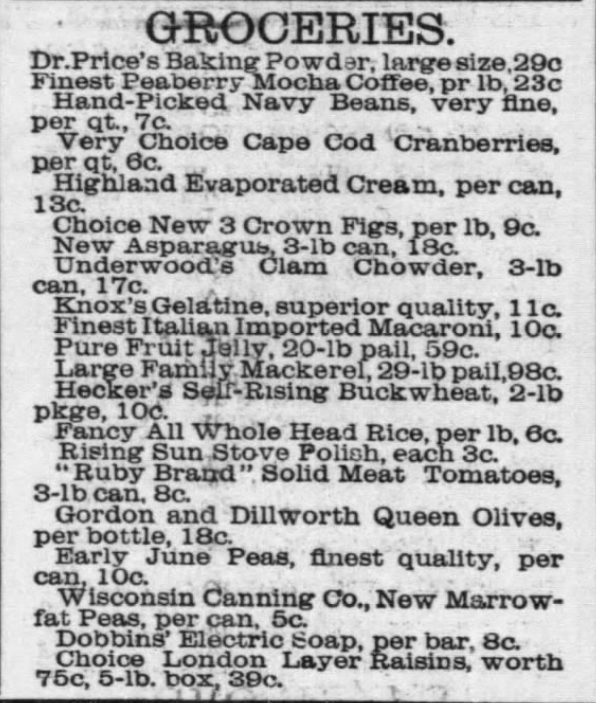
In a list of GROCERIES for sale in Chicago Tribune, Chicago, Illinois on October 11, 1891. See “Knox’s Gelatine (slightly above center line), superior quality, 11c.” See prices of other grocery items: canned peas or asparagus, bars of soap, baking powder and coffee.
.
The 11 cent price tag on Knox’s Gelatine in 1891 is the same as $4.25 in 2021‘s dollars. [Source]
.

Grocery Prices advertised, including Knox’s Gelatin, priced at 2 for 25c. Published in The Kansas City Star of Kansas City, Missouri on April 5, 1892. Notice the inclusion of cream cheese (2 lbs. for 25c) and sweet chocolate (6 cakes for 25c).
.
Those two boxes of Knox’s Gelatine for 25 cents in 1892 equals $8 in 2021 dollars. [Source]
.

Listed among “needs” in Groceries, Knox’s Gelatine advertised at 10c. From Omaha Daily Bee of Omaha, Nebraska on June 4, 1892.
.
10 cents in 1892 equals $3 in 2021‘s dollars. [Source]
.
Related Articles
.
.
Updated July 2022
Copyright © 2022 Kristin Holt LC
Victorian Jelly: Commercial Gelatin Victorian Jelly: Commercial Gelatin Victorian Jelly: Commercial Gelatin

